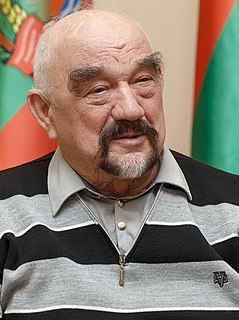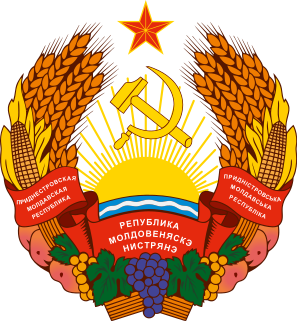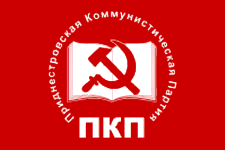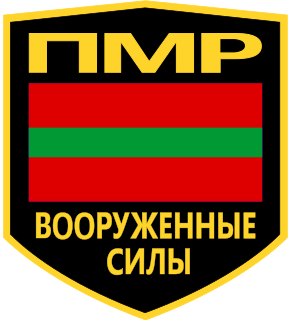
Tiraspol is internationally recognised as the second largest city in Moldova, but is effectively the capital and administrative centre of the unrecognised Pridnestrovian Moldavian Republic (Pridnestrovie). The city is located on the eastern bank of the Dniester River. Tiraspol is a regional hub of light industry, such as furniture and electrical goods production.

Transnistria, Transdniestria, or Pridnestrovie, officially the Pridnestrovian Moldavian Republic, is a breakaway state in a narrow strip of land between the river Dniester and the Ukrainian border that is internationally recognized as part of Moldova. Its capital is Tiraspol. Transnistria has been recognised only by three other mostly non-recognised states: Abkhazia, Artsakh, and South Ossetia.

Igor Nikolaevich Smirnov is a Transnistrian politician who served as the first president (1991–2011) of the internationally unrecognized Pridnestrovian Moldovan Republic.

The Transnistria War was an armed conflict that broke out in November 1990 in Dubăsari between pro-Transnistria forces, including the Transnistrian Republican Guard, militia and Cossack units, and pro-Moldovan forces, including Moldovan troops and police. Fighting intensified on 1 March 1992 and, alternating with ad hoc ceasefires, lasted throughout the spring and early summer of 1992 until a ceasefire was declared on 21 July 1992, which has held. The conflict remained unresolved, but in 2011 talks were held under the auspices of the Organization for Security and Cooperation in Europe (OSCE) with Lithuania holding the rotating chairmanship.

The political status of Transnistria, a self-proclaimed state on the internationally recognized territory of Moldova, has been disputed since the Transnistrian declaration of independence on 2 September 1990. This declaration sought to establish a Soviet Socialist Republic that would be independent from local Moldovan authority. Following the breakup of the Soviet Union and Moldova's own declaration of independence in 1991, the Pridnestrovian Moldavian Soviet Socialist Republic (PMSSR) was transformed into the Pridnestrovian Moldavian Republic (PMR). However no United Nations member country recognizes the PMR's independence.
Aleksandr Radchenko was an ethnic Ukrainian politician and human rights activist from Transnistria. A former Soviet military officer, he was the editor of a small opposition newspaper in Tiraspol called Chelovek i ego prava. Most of his articles deal with human rights issues.
This is a survey of the postage stamps and postal history of Transnistria, an unrecognized breakaway territory of Moldova and the de facto independent Pridnestrovian Moldavian Republic.

Although most commonly known in English as Transnistria, the official name of the region is Pridnestrovie. Here is a detailed explanation of the names used for Transnistria, both official and unofficial, as they appear in the local languages and in English.

The state of affairs with human rights in Transnistria has been criticized by several governments and international organizations. The Republic of Moldova, and other states and non-governmental organizations (NGOs) claim that the government of Transnistria is authoritarian and has a record of arbitrary arrest and torture.

The Pridnestrovie Communist Party is a communist party in the unrecognized state of Transnistria, led by Oleg Khorzhan until his arrest and imprisonment in 2018.
Crime in Transnistria covers criminality-related incidents in the breakaway Republic of Transnistria, still nominally part of Moldova. The police organisations of Transnistria are tasked with fighting crime in the republic.

This timeline of events is a chronological list of incidents and other notable occurrences related to the War of Transnistria, including events leading up to the war.

Roman Yevgenyevich Konoplev is a Russian political and public figure, strategist, publicist, writer, now resident in Portugal.

The following outline is provided as an overview of and topical guide to Transnistria:

Standard license plates of Transnistria are 520 mm wide and 112 mm high, made of metal with 6 embossed characters - one letter, three numbers and two more letters - written using the DIN 1451 Mittelschrift font. On the left part of the plates there also a modified euroband on a white background, having the flag of the PMR instead of the EU symbol, and a holographic sticker in the place of the international country code underneath it. Government plates only have 5 embossed characters - three numbers and two letters. Only symbols that are common to both the Cyrillic and the Latin alphabets are used, and with their Cyrillic meaning. Its current design derives from Moldovan plates of 1992 design, but is slightly changed. Military plates are using Soviet design from 1959, and tractor plates are also using Soviet design, but from 1980.

The Armed Forces of the Pridnestrovian Moldavian Republic, are the military forces of the semi-recognised state of Transnistria. The Armed Forces were created on 6 September 1991 to protect the sovereignty and independence of the Pridnestrovian Moldavian Republic, in accordance with Article 11 of the Republic's Constitution.
Ernest Vardanean is a journalist and political scientist who lives in the breakaway Moldovan region of Transnistria. He was arrested on 7 April 2010 by the self-proclaimed forces in Tiraspol charged of high treason in favor of the Republic of Moldova.

Transnistria is a region in Eastern Europe, a narrow strip of territory to the east of the River Dniester. The PMR controls the main part of this region, and also the city of Bender and its surrounding localities on the west bank, in the historical region of Bessarabia.

The news agency Lenta PMR was a non-governmental, nationwide online news service disseminating news from Transnistria, Moldova and abroad.
The First Transnistrian, also known as TV PMR, is a public television channel from Transnistria, an unrecognized republic officially part of Moldova. It began broadcasting on 9 August 1992 and is available in the Moldovan, Russian and Ukrainian languages. It was established by the Government of Transnistria and the Supreme Council to replace Moldovan media that allegedly widespreaded "distorted facts" and "blocked the transmission of reliable information about events in the region".












